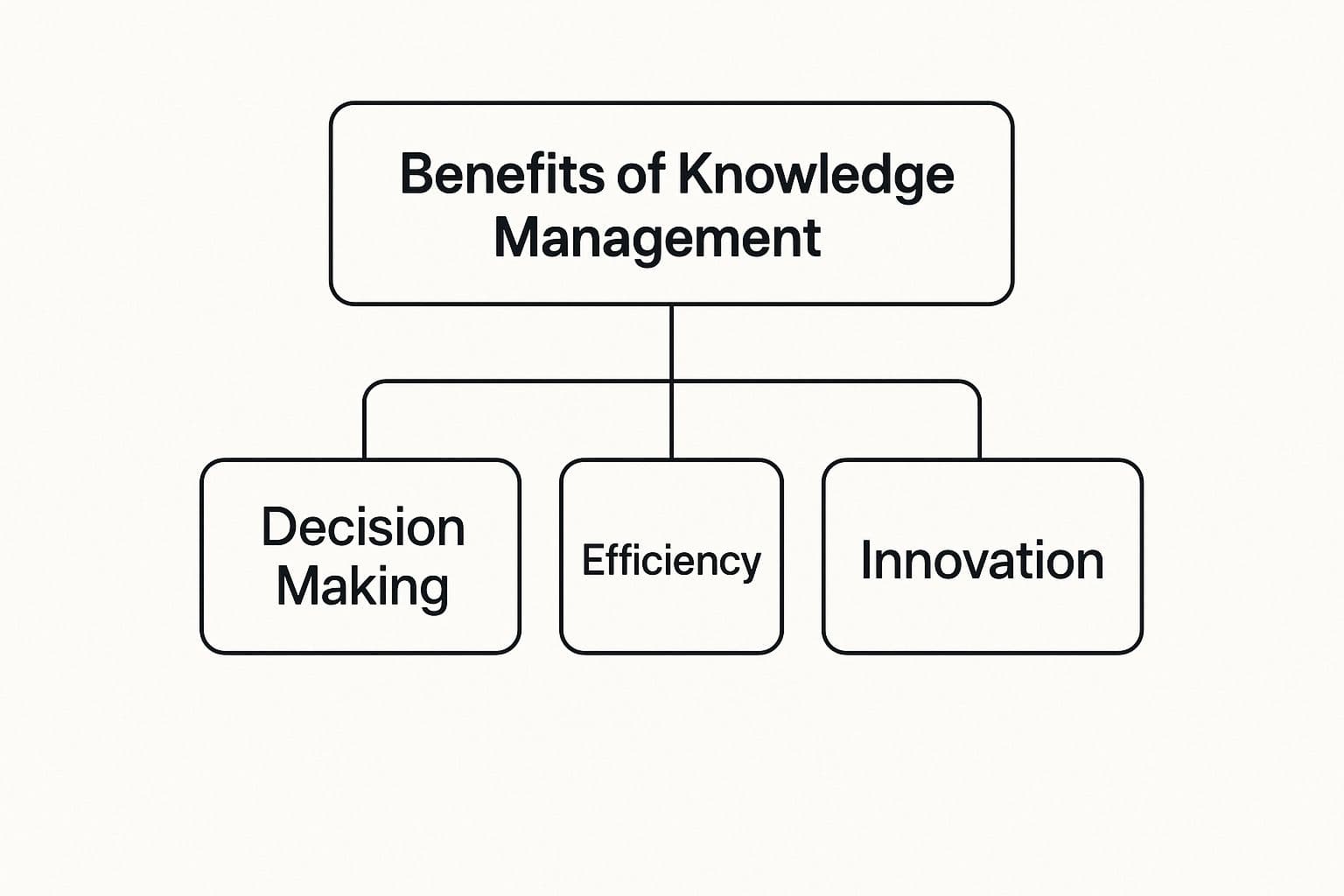Think about all the expertise locked away inside your organization. It’s in the heads of your senior engineers, the notebooks of your top salespeople, and the chat histories of your project managers. Knowledge management is simply the process of getting all that valuable information out of those silos and turning it into a shared, accessible company resource.
It’s about making sure that when someone figures out a better way to do something, that insight doesn’t just stay with them. It becomes part of the company's DNA, so everyone can benefit from it long after that person has moved on.
What Does Knowledge Management Look Like Day-to-Day?

Picture your company’s collective brainpower as a massive, messy library. The good stuff is in there somewhere, but it’s scattered across thousands of emails, endless Slack threads, and dozens of personal hard drives. The most valuable information? That often lives only in the minds of your most experienced people.
When a key team member leaves, it’s like a whole section of that library just vanished. That’s the exact problem knowledge management is designed to solve. It acts as the master librarian for your company's know-how.
By putting a solid system in place, you start turning all that scattered data into a well-organized, searchable resource. It's less about creating a static archive and more about building a culture where sharing and learning are just part of the daily workflow.
The Team Cookbook Analogy
A great way to think about this is to imagine your company is a restaurant and its knowledge is a shared digital cookbook.
Every chef has their own secrets—a specific technique for searing a steak, a tip for keeping greens fresh, or a shortcut for prepping veggies. Without a central place to store this wisdom, these "recipes for success" are gone the second a chef calls in sick or finds a new job. A good knowledge management strategy is the cookbook that captures it all.
Here’s how it breaks down:
- Capturing Knowledge: This is the chef meticulously writing down their signature recipe. In a business context, it could be documenting the steps of a successful marketing campaign or learning how to take better meeting notes to capture critical decisions.
- Organizing Knowledge: The recipes in the cookbook are neatly sorted by course—appetizers, entrees, desserts. This makes it simple to find exactly what you're looking for. In the same way, business knowledge gets tagged and filed by project, department, or topic so it’s easy to retrieve.
- Sharing and Using Knowledge: A new line cook can pull up a tested recipe and immediately start making a perfect, consistent dish. In your company, a new hire can tap into the knowledge base to solve a tricky customer problem on day one, without having to ask a dozen people for help.
The Four Pillars of an Effective KM Strategy
A solid knowledge management strategy doesn't just happen. It's built on four core processes that work together in a continuous loop, making sure your company's collective wisdom is saved and actively used to push the business forward.
Think of it like building a sturdy table—if one of the four legs is shaky, the whole thing wobbles. Understanding these pillars is the first real step in turning scattered information into an organized, powerful asset. Let's break down each one.
1. Knowledge Capture
The first, and maybe most important, pillar is knowledge capture. This is all about getting those valuable insights out of individual employees' heads and into a system where everyone can access them.
This has always been a huge challenge. Studies show that a staggering 70% of organizational knowledge is tacit—it’s the stuff that lives in people's minds as experience and intuition. When that knowledge isn't captured, it walks right out the door every time an employee leaves.
Getting this right can make a huge difference. Some companies have seen a 30% reduction in training time just by making expert knowledge easy for newcomers to find. You can find more stats that highlight this challenge in this article from Cake.com.
2. Knowledge Organization
Once you’ve captured all that great information, you need to organize it. This pillar is about creating a logical structure so people can actually find what they're looking for when they need it.
Without good organization, your knowledge base can quickly turn into a digital junk drawer. It’s full of valuable stuff, but it's so messy that it's useless.
Effective organization usually involves:
- Categorization: Grouping related information under clear, intuitive headings (like "Sales Best Practices" or "Marketing Campaign Templates").
- Tagging: Using keywords to make documents and articles searchable, even across different categories.
- Standardization: Creating consistent formats and templates so users know what to expect and where to find key details in any document.
This image really drives home how these pillars support key business goals like better decision-making and efficiency.

As the diagram shows, a well-managed knowledge ecosystem directly fuels your core business functions, leading to smarter, faster operations across the board.
3. Knowledge Sharing
Knowledge that just sits there has no value. The third pillar, knowledge sharing, is focused on getting information to the right people at the right time.
This is where your company culture becomes critical. You have to build an environment where employees feel encouraged—and safe—to share what they know without worrying about judgment.
Tools like internal wikis, team collaboration platforms, and even regular meetings are essential, but they only work if the culture supports them.
4. Knowledge Application
Finally, the cycle is complete with knowledge application. This is the ultimate goal: getting teams to actually use the shared knowledge to improve their work, make smarter decisions, and stop repeating past mistakes.
This last pillar ensures your KM system isn’t just a dusty digital library. It becomes a dynamic tool that delivers real, measurable business results. When people consistently apply the collective wisdom of the organization, the whole company learns, adapts, and gets stronger.
To bring it all together, here's a simple breakdown of the four pillars and what they involve.
The Four Pillars of Knowledge Management
Each of these pillars is essential. By focusing on capturing, organizing, sharing, and applying knowledge, you create a self-sustaining cycle of continuous improvement that benefits everyone.
Why Knowledge Management Is a Business Superpower
Putting a knowledge management system in place isn't just another item on the to-do list—it's a game-changing investment with real, measurable returns. When you start treating your company's collective wisdom as a core asset, you fundamentally change how your teams work, create, and tackle problems. It's this shift that separates the good companies from the great ones.
Just think about all the hours wasted when someone has to reinvent the wheel every time a new challenge pops up. A solid KM system cuts out that waste by making proven solutions and best practices easy to find. That means less time hunting for answers and more time pushing the business forward.

Accelerate Decision Making
Good knowledge management puts critical insights and historical data right at your fingertips. When leaders and their teams face a tough call, they can instantly pull up what happened on similar projects in the past—seeing what worked and, just as importantly, what didn't. This reliable "organizational memory" replaces educated guesses with data-driven confidence.
Instead of making decisions based on one person's opinion, teams can tap into a rich pool of shared experience. The result? Smarter, faster, and more consistent decisions across the board, which naturally leads to better outcomes and fewer risks.
Fuel Innovation and Growth
Real innovation doesn't just appear out of thin air. It’s built on the shoulders of past successes and the hard lessons learned from failures. By creating a single place for project results, customer feedback, and market research, you’re essentially handing your teams the raw materials they need to innovate.
Imagine a product team that can easily review the entire history of a feature request. They’re in a much better position to build something that customers will actually love. This continuous loop of learning and improving is what drives sustainable growth.
The market reflects this value. The global Knowledge Management System market was valued at USD 28.15 billion and is expected to hit USD 84.5 billion by 2031, growing at a compound annual rate of 17%. This boom shows a clear global trend toward working smarter, not harder. You can read more about this market growth on Business Research Insights.
Streamline Onboarding and Support
A well-organized knowledge base is a secret weapon for new hires and customer support alike. For new employees, it drastically cuts down the time it takes to get up to speed. They have a self-service resource to find answers to everything from company policies to tricky operational steps.
This same resource empowers your customer support agents. With immediate access to correct product info and troubleshooting guides, they can solve customer problems way faster and more accurately. This pays off in several huge ways:
- Reduced Training Time: New team members start contributing much sooner.
- Improved First-Contact Resolution: Support agents can solve issues on the first try.
- Enhanced Customer Satisfaction: Customers get quick, reliable answers.
- Increased Employee Confidence: Your team feels prepared to handle whatever comes their way.
How to Build Your First Knowledge Management System
Building a knowledge management system from the ground up can feel like a huge undertaking. The good news? You don't have to boil the ocean. The trick is to start small, focus on solving one real problem, and show value right away.
First, figure out where the biggest knowledge gaps are in your organization. Is your sales team constantly reinventing the wheel to find the latest product specs? Are new hires spending months just trying to figure out who knows what? Finding these high-impact pain points gives you a clear starting line and makes it much easier to get leadership on board.
Start with a Clear Goal
Once you've zeroed in on a problem, you need to set a concrete, measurable goal. A fuzzy objective like "improve knowledge sharing" is impossible to track. You need something specific you can actually aim for.
Think along these lines:
- Reduce new hire onboarding time by 25% by creating a one-stop shop for all training docs, videos, and process guides.
- Decrease customer support ticket response time by 15% by building an internal FAQ with ready-to-go answers for common issues.
- Cut down on repetitive questions in team meetings by making sure all key decisions and project updates are documented in a shared space.
A focused goal does more than just guide your work. It gives you a clear success story to tell when you show everyone how valuable knowledge management really is.
Select the Right Tools for the Job
With a clear goal in hand, it's time to pick your tools. You probably don't need a massive, expensive platform right out of the gate. In fact, the best tools are often the ones your team is already using every day, which makes getting people to actually use them a whole lot easier.
Depending on your goal, you could start with:
- Internal Wikis: Tools like Confluence or Notion are fantastic for creating collaborative documents, project roadmaps, and team handbooks.
- Shared Drives: Something as simple as Google Drive or OneDrive can work perfectly as a central spot for files, spreadsheets, and presentations.
- Communication Platforms: You can capture a surprising amount of knowledge just by creating dedicated channels in Slack or Microsoft Teams for specific projects or topics.
For more complex needs, dedicated knowledge base software like Guru or Zendesk might be the answer. But the most important thing is to pick something that fits your goal and won't feel like a chore for your team to use. It’s also critical to capture the insights from meetings, and tools that offer powerful meeting search capabilities can make finding that one key decision from months ago a breeze.
Foster a Culture of Sharing
Here’s the thing: technology is only half the battle. The best knowledge management systems are built on a culture where people naturally share what they know. This is often the hardest part, but it’s also where the real magic happens.
So, how do you build that culture? Start by finding your knowledge champions—those enthusiastic folks who can get others excited and show them the ropes. Weave the new system into your existing workflows. For example, make it a standard part of project wrap-ups to document key lessons in the wiki. When sharing knowledge becomes an easy and recognized part of the job, your simple repository will transform into a living, breathing asset for the whole company.
How AI Is Revolutionizing Knowledge Management

Let's be honest: traditional knowledge management systems can feel like a digital junkyard. They’re great for storing things, but when you actually need to find something specific, it’s a nightmare. Artificial intelligence is flipping that entire model on its head. It’s turning those dusty digital archives into smart, helpful assistants that know what you need, sometimes even before you do.
Think of AI as the ultimate librarian for your company's collective brain. Instead of you digging through endless folders and old documents, AI-powered tools can understand what you're asking and pull up the exact answer in seconds. This finally solves one of the oldest problems in knowledge management: actually finding the information you’ve so carefully stored away.
Automating Knowledge Capture and Discovery
One of the biggest game-changers AI brings to the table is automating the mind-numbing work of capturing knowledge in the first place. Just think about all the brilliant ideas, crucial decisions, and key insights that vanish the moment a meeting ends. With AI, those conversations don't just disappear.
AI tools can now join your meetings to record, transcribe, and summarize everything that was said. Suddenly, a free-flowing conversation becomes a structured, searchable piece of company knowledge. Key action items, decisions, and important topics are all pulled out and tagged automatically—no one has to lift a finger.
If you want to see this in action, checking out some of the best AI meeting assistant tools of 2025 is a fantastic way to start building a knowledge base that practically builds itself.
This move toward automation is huge. The market is already showing a strong preference for cloud-based platforms, which make up about 62.66% of the market and make it so much easier to plug in AI tools. And what's the fastest-growing use case? Intelligent chatbots, which are expanding at a staggering 22.4% as more companies use them to give employees instant answers. You can dig into more of these trends and find more insights on this market growth on Technavio.
Making Knowledge Proactive, Not Reactive
The real magic of a modern knowledge management strategy is getting information to people proactively. Instead of making an employee stop what they're doing to search for an answer, AI can serve up the right knowledge at the right time, right inside the tools they already use.
Here’s what that actually looks like:
- In-the-Moment Support: A sales rep mentions a specific customer objection in a team chat, and an AI assistant instantly pops up with a link to the perfect playbook for handling it.
- Intelligent Onboarding: A new hire can just ask a chatbot questions in plain English—"What's our vacation policy?"—and get immediate answers pulled from HR docs and internal guides.
- Content Gap Analysis: The AI can notice when people are searching for topics that have no answers in the knowledge base. It then flags those gaps so your experts know exactly what new content is needed.